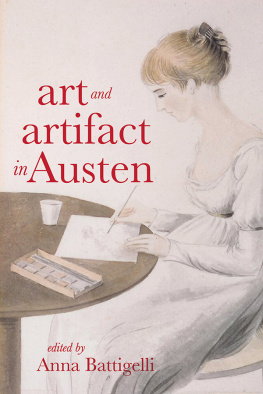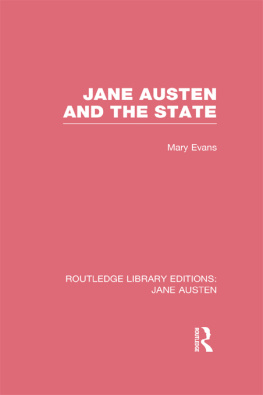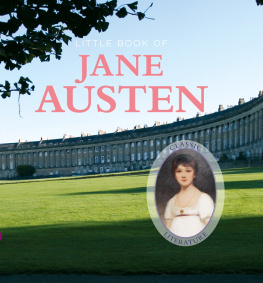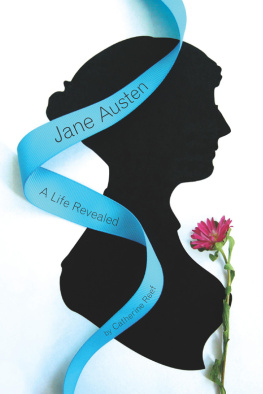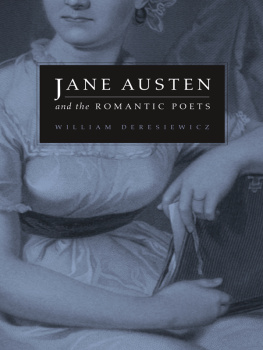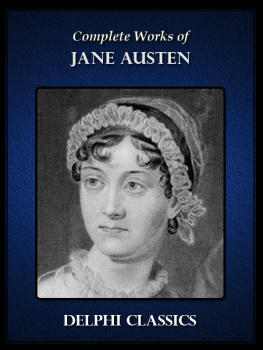Battigelli Anna - Art and Artifact in Austen
Here you can read online Battigelli Anna - Art and Artifact in Austen full text of the book (entire story) in english for free. Download pdf and epub, get meaning, cover and reviews about this ebook. publisher: University of Delaware Press, genre: Art. Description of the work, (preface) as well as reviews are available. Best literature library LitArk.com created for fans of good reading and offers a wide selection of genres:
Romance novel
Science fiction
Adventure
Detective
Science
History
Home and family
Prose
Art
Politics
Computer
Non-fiction
Religion
Business
Children
Humor
Choose a favorite category and find really read worthwhile books. Enjoy immersion in the world of imagination, feel the emotions of the characters or learn something new for yourself, make an fascinating discovery.
- Book:Art and Artifact in Austen
- Author:
- Publisher:University of Delaware Press
- Genre:
- Rating:5 / 5
- Favourites:Add to favourites
- Your mark:
- 100
- 1
- 2
- 3
- 4
- 5
Art and Artifact in Austen: summary, description and annotation
We offer to read an annotation, description, summary or preface (depends on what the author of the book "Art and Artifact in Austen" wrote himself). If you haven't found the necessary information about the book — write in the comments, we will try to find it.
Art and Artifact in Austen — read online for free the complete book (whole text) full work
Below is the text of the book, divided by pages. System saving the place of the last page read, allows you to conveniently read the book "Art and Artifact in Austen" online for free, without having to search again every time where you left off. Put a bookmark, and you can go to the page where you finished reading at any time.
Font size:
Interval:
Bookmark:

University of Delaware Press
2020 by Anna Battigelli
All rights reserved
Printed in the United States of America on acid-free paper
First published 2020
978-1-64453-174-7 (cloth)
978-1-64453-175-4 (paper)
978-1-64453-176-1 (e-book)
9 8 7 6 5 4 3 2 1
Library of Congress Cataloging-in-Publication Data is available for this title.
Cover art: Cassandra Austen, portrait of Fanny Knight, 1808, watercolor on paper.
(Jane Austens House Museum, Chawton, UK)
Illustrations
Acknowledgments
An edited volume is a group effort. I am deeply fortunate to have worked on this project with so many talented and amiable scholars and colleagues. The essays in this volume expand and enrich a dialogue begun at SUNY Plattsburghs 2017 bicentenary conference Jane Austen and the Arts. Conference participants, both those presenting papers and those responding to them, engaged in discussions that continued long after the conference and eventually resulted in this volume. Nancy Johnson, Deborah Payne, Natasha Duquette, Kym Taylor, Paul K. Johnston, James A. Winn, Paula Backscheider, Mary-Nell Bockman, and my splendid colleagues and students in the English Department at SUNY Plattsburgh provided skilled and incisive support leading up to conference. Two former studentsKym Taylor and Megan Thronewere crucial to the conferences success, both through their rich understanding of Jane Austens work and through their personal contributions to the conference. The revised essays benefited from the incisive readers reports provided by the University of Delaware Press. A semester at the University of Tulsa as the Bell Visiting Professor of Anglican Studies provided valuable editing time. Lisa B. Nurme and Giovanna Battigelli offered indispensable help regarding permissions. Mario Battigelli continued his work as an invaluable research assistant. Special thanks to the contributors, whose good cheer and Austenian attention to detail made them a delight to work withas did their facility in meeting deadlines, offering crucial suggestions, and producing the stimulating essays in this volume.
Conferences cannot happen without an institutions financial support, and SUNY Plattsburghs bicentenary conference was sponsored in part by the SUNY Conversations in the Disciplines Program of the State University of New York. It also received support from SUNY Plattsburgh, particularly from Dean Andrew Buckser, Provost James Liszka, and President John Ettling. The skilled and efficient staff members of Feinberg Librarys interlibrary loan officeEthel Facteau and Mila Sumade this volume possible. The members of the editorial staff at the University of Delaware Press were unfailingly helpful. The Metropolitan Museum of Art and the Morgan Library generously provided images for use at the conference. Staff from Chawton House and the Jane Austens House Museum generously fielded queries regarding Austens art and artifacts.
Abbreviations
E Austen, Jane. Emma. The Cambridge Edition of the Works of Jane Austen. Edited by Richard Cronin and Dorothy McMillan. Cambridge: Cambridge University Press, 2005.
J Austen, Jane. Juvenilia. The Cambridge Edition of the Works of Jane Austen. Edited by Peter Sabor. Cambridge: Cambridge University Press, 2006.
Letters Austen, Jane. Jane Austens Letters. Edited by Deirdre Le Faye. 4th ed. Oxford: Oxford University Press, 2011.
LM Austen, Jane. Later Manuscripts. The Cambridge Edition of the Works of Jane Austen. Edited by Janet Todd and Linda Bree. Cambridge: Cambridge University Press, 2008.
MP Austen, Jane. Mansfield Park. The Cambridge Edition of the Works of Jane Austen. Edited by John Wiltshire. Cambridge: Cambridge University Press, 2005.
NA Austen, Jane. Northanger Abbey. The Cambridge Edition of the Works of Jane Austen. Edited by Barbara M. Benedict and Deirdre Le Faye. Cambridge: Cambridge University Press, 2006.
P Austen, Jane. Persuasion. The Cambridge Edition of the Works of Jane Austen. Edited by Janet Todd and Antje Blank. Cambridge: Cambridge University Press, 2006.
P&P Austen, Jane. Pride and Prejudice. The Cambridge Edition of the Works of Jane Austen. Edited by Pat Rogers. Cambridge: Cambridge University Press, 2006.
S&S Austen, Jane. Sense and Sensibility. The Cambridge Edition of the Works of Jane Austen. Edited by Edward Copeland. The Cambridge Edition of the Works of Jane Austen. Cambridge: Cambridge University Press, 2006.
Introduction
The Intimate Ironies of Jane Austens Arts and Artifacts
Jane Austen was immersed in the arts. She loved dancing. She was a proficient pianist who practiced daily and collected and transcribed piano scores. She subscribed to libraries, read voraciously, and commented in her letters on novels and sermons, even as she described bonnets, textiles, window blinds, quilts, and balls. That the family transmitted its love of the arts to the next generation of Austens is evident in the manuscripts sent to her by her nephew James Edward Austen and her nieces Anna Lefroy, Fanny Knight, and Caroline Austenall aspiring novelists. For the extended Austen family as for others during the long eighteenth century, creating art and domestic artifacts was an indispensable means of understanding and engaging with ones world.
Playing the piano, singing, dancing, or drawing provided entertainment in Regency and Georgian England, but more humble domestic arts were also essential to the practical and emotional ordering of daily life.
In conduct books and sermons, such accomplishments were encouraged as part of a young womans preparation for marriage. Elsewhere, however, womens education in the arts was viewed as both subordinating and debasing. Mary Wollstonecraft objected to the smattering of accomplishments that impeded the more rigorously intellectual education necessary for independence of mind. Similarly, in Austens novels, womens work briefly stalls narrative action to convey the emotional undertow it masks or regulates. The writer who transformed narrative technique by powerfully intensifying its capacity to represent mental activity through free indirect discourse also learned a great deal in the parlor by observing how visual cues revealed inner thought. As friends and family members alternately worked in contented concentration or threw down and picked up objects in restless unease, Austen stockpiled mental images demonstrating how people unwittingly expose their states of mind as they take up needles, sharpen a pen, or open and then close a book.
It should not surprise us, then, that in her novels Austen uses a broad range of arts and artifacts, from sewing needles to estates, both to zoom into a characters subjective mental experience and to zoom out to the larger social and political world of Regency and Georgian England. Her emphasis on interiority makes her novels intellectually and emotionally atmospheric: characters think, feel, reflect, judge, and consider. Computer analysis of Austens language confirms what we already know: her vocabulary fingerprint consists of the largely abstract language of thought and feeling. Larger artifacts, such as estates, landscapes, and gardens are also put to use. Elizabeth Bennet is stunned by the view of Pemberley, which is situated so as to surprise and impress visitors. The road leading to the estate constitutes a narrative experience through which visitors like Elizabeth arrive at the top of a considerable eminence, where the wood ceased, only to have their eye instantly caught by Pemberley House, situated on the opposite side of a valley, into which the road with some abruptness wound (
Next pageFont size:
Interval:
Bookmark:
Similar books «Art and Artifact in Austen»
Look at similar books to Art and Artifact in Austen. We have selected literature similar in name and meaning in the hope of providing readers with more options to find new, interesting, not yet read works.
Discussion, reviews of the book Art and Artifact in Austen and just readers' own opinions. Leave your comments, write what you think about the work, its meaning or the main characters. Specify what exactly you liked and what you didn't like, and why you think so.

